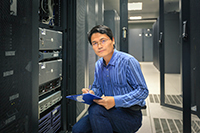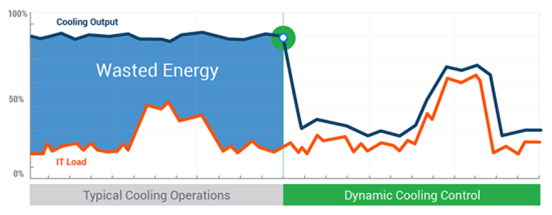By Daniel Bodenski, PE, LEED AP, Director of Strategic Solutions
 With growing energy costs and data center energy consumption nearly 100 times higher than that of a typical commercial building, data center owners and operators are placing a higher focus on improving energy efficiency within their facilities. Maintaining energy efficiency is critical to running a reliable, high-capacity, and cost-efficient mission-critical facility. At Electronic Environments Co. (EEC), we are dedicated to enabling our clients to develop the most efficient and profitable data centers possible, allowing for maximum uptime while minimizing capital and operational costs.
With growing energy costs and data center energy consumption nearly 100 times higher than that of a typical commercial building, data center owners and operators are placing a higher focus on improving energy efficiency within their facilities. Maintaining energy efficiency is critical to running a reliable, high-capacity, and cost-efficient mission-critical facility. At Electronic Environments Co. (EEC), we are dedicated to enabling our clients to develop the most efficient and profitable data centers possible, allowing for maximum uptime while minimizing capital and operational costs.
When it comes to data center energy efficiency, there are six key ways you can improve your bottom line while still ensuring total reliability. Below, we will examine these key strategies and help you answer the question, “How can my data center be more energy efficient?”
1. Assessments
Performing a detailed assessment of your data center’s operational performance will give you clear and concrete insight into the particular ways your data center can be improved, outlining the individual areas in which current energy efficiency practices may fall short. Review of airflow management, implementing a detailed PUE analysis, and obtaining real-time data hall temperature measurements, are all important metrics to assess in order to develop a fully strategic plan to lower energy costs. Data center assessment professionals are equipped to provide comprehensive results through in-depth analysis and can provide recommendations for design, installation and maintenance improvements resulting in quick and cost-effective solutions. An assessment can also be used to prepare for external audits, and provide foundational data for developing thorough strategies.
2. Equipment Upgrades
As society evolves, so too do our technologies, putting increased demand on data center capabilities. Equipment upgrades are necessary to maintain a robust and reliable facility. Moreover, in order to make data centers increasingly efficient, new technologies are continually developed that reduce overall energy consumption, such as ECO mode Uninterruptible Power Supply (UPS), 380V DC power systems, lighting system retrofits, efficient chillers, and more. By knowing what new technologies exist and understanding the return on investment of many of these upgrades, you may be able to use many to your advantage within your data center’s lifecycle.
3. Maintenance
 If your current equipment is unreliable or beyond its normal lifespan, it could be adding to your operating costs and could pose a serious threat to reliability. Downtime is the number one critical issue, as it will not only hurt your bottom line, but your reputation as a reliable organization. The Ponemon Institute reports that data center downtime costs an average of $7,900 per minute. Can you afford that? By employing a comprehensive maintenance routine, trained specialists should be engaged to check generator heaters and batteries, test load banks, sample generator coolant, fuel and oil, and regularly exercise overcurrent protective devices. These activities, coupled with implementation of an on-demand Asset Management system, will increase operational efficiency and reduce overall critical system downtime.
If your current equipment is unreliable or beyond its normal lifespan, it could be adding to your operating costs and could pose a serious threat to reliability. Downtime is the number one critical issue, as it will not only hurt your bottom line, but your reputation as a reliable organization. The Ponemon Institute reports that data center downtime costs an average of $7,900 per minute. Can you afford that? By employing a comprehensive maintenance routine, trained specialists should be engaged to check generator heaters and batteries, test load banks, sample generator coolant, fuel and oil, and regularly exercise overcurrent protective devices. These activities, coupled with implementation of an on-demand Asset Management system, will increase operational efficiency and reduce overall critical system downtime.
4. Dynamic Cooling Management
Every data center is unique, so its cooling solutions should be as well. Cooling plays a critical role in the energy efficiency of a data center. Finding the correct model for your individual facility is of capital importance.
With a dynamic cooling model that’s easy to deploy, you can see immediate energy savings, more efficient network transformation, and increased network reliability. Instead of zone-level control, fans are individually optimized based on real-time readings, utilizing rack sensors and control modules to collect temperature requirements and Computer Room Air Conditioning (CRAC) airflow and power metrics, resulting in a fully optimized, intelligent cooling system.
5. Airflow Management
Poor airflow management leads to a lot of undesirable results, including the recirculation of supply air, causing hotspots and reducing the overall effectiveness of the data center’s cooling plant. By implementing simple airflow management techniques, such as adding floor grommets, implementing partial or full containment, and adding blanking panels, data center operators can see reduced plenum losses, and immediate energy savings. This is a simple, low-cost method to reap instant financial benefits and improve Power Usage Effectiveness (PUE).
6. Baseline Energy Reduction
Sustainable energy sources such as solar, fuel cell and wind power are becoming more and more commonplace within data centers to reduce overall energy use, shrink their carbon footprint and become more energy independent. Not only can sustainable energy sources reduce energy usage, self-contained power plants can also offer data center operators the option to develop a micro-grid, which decreases the reliance on an aging, electrical infrastructure and provides a strategy for modular data center solutions.
 To learn more about these six strategies for enhanced energy efficiency, check out our eBook,"6 Ways To Improve Data Center Energy Efficiency".
To learn more about these six strategies for enhanced energy efficiency, check out our eBook,"6 Ways To Improve Data Center Energy Efficiency".
If you would like more information about any of these solutions or feel that you could benefit from customized professional assistance, please visit www.eecnet.com or email us at info@eecnet.com.


